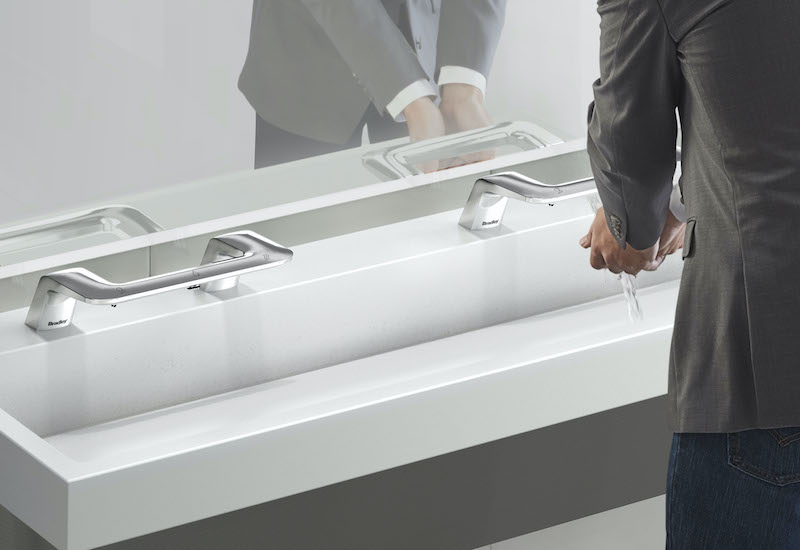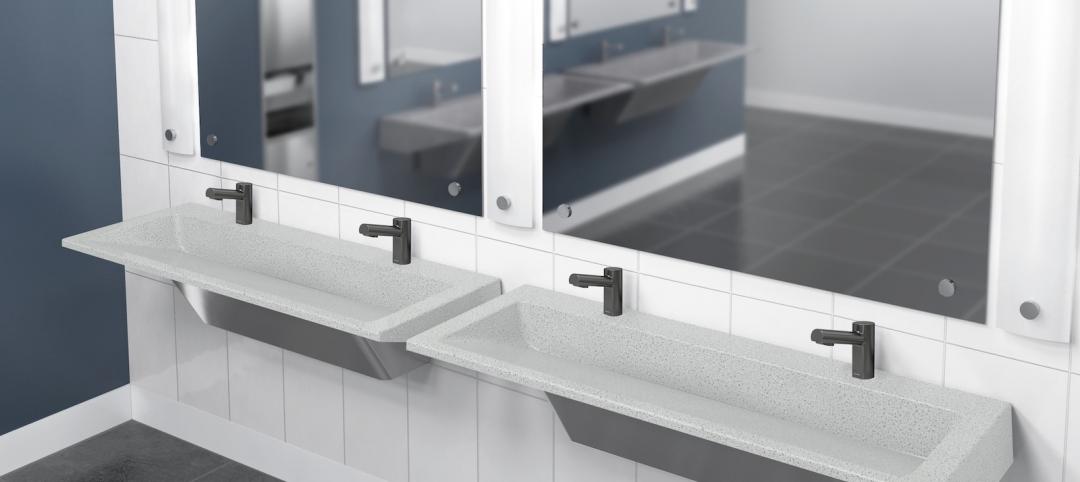Germaphobes rejoice! Public restrooms may soon become a much more sanitary place than they have been in the past thanks to the effects of COVID-19.
As the novel coronavirus spread rapidly around the world, people quickly became aware that perhaps the obsessive hand-washing, any-bathroom-is-touchless-if-you-try-hard-enough germaphobes among us may have had the right idea. And now, it is time for public restroom design to catch up to the current state of affairs.
“As businesses and public establishments reopen and Americans return to using facilities, all eyes are on public restrooms,” says Jon Dommisse, Director of Strategy and Corporate Development, Bradley Corp. “Today’s commercial washroom will be of paramount importance in providing hand washing systems and supplies, and mitigating sickness-causing germs.”
Below are commercial restroom upgrades, as outlined by Bradley Corp., to help improve hand washing and minimize germs.
1. Post signage. Reinforce cleanliness with friendly reminders about washing hands for 20 seconds per Centers for Disease Control (CDC) guidelines, maintaining safe distances between users, throwing away paper towels, etc. The Healthy Hand Washing Survey by Bradley Corp. shows that 40% of Americans increase hand washing when signs are posted.
2. Offer touchless fixtures. Cross contamination of germs in restrooms can be reduced by using touch-free fixtures for everything from soap, faucets, hand dryers/towels, doors and flushers. Public health experts agree: “Under any circumstance, using touchless fixtures helps to inhibit the spread of germs in restrooms and buildings,” says medical microbiologist Michael P. McCann, Ph.D., Professor of Biology, Saint Joseph's University. “The more we avoid restroom touchpoints, the healthier and easier our operations will be. Hands-free washrooms are a win-win for consumers and businesses.”
Research shows that consumers are highly in favor of using touch-free fixtures. “91% of Americans believe it’s extremely or somewhat important that public restrooms are equipped with touchless fixtures,” Dommisse said. “In fact, making everything touchless is Americans’ most requested improvement in restrooms.”
3. Increase cleaning, sanitization and restocking. Proper and frequent cleaning and disinfection is key for restrooms, especially for high-touch surfaces, such as doorknobs, faucets, sinks, toilets, stall door openers and paper towel dispensers. According to the CDC, daily cleaning with soap and water reduces germs, dirt, and impurities on the surface, and should be done frequently, especially if there is high traffic.
“It’s also important to disinfect surfaces to kill germs at least once daily, and more often if the restroom is busy,” Dr. McCann said. Finally, be sure to check and restock supplies regularly. Experiencing unclean low-stocked restrooms are pet peeves for restroom users.
4. Provide trash cans and hand sanitizer near exits. “Our research shows that 65% of Americans use paper toweling to avoid contact with restroom doors and faucets,” Dommisse said. “Keeping paper towels and waste containers near doorways can be helpful so people can throw them away upon exiting.”
Installing hand sanitizers outside restrooms is another way people can sanitize their hands upon entering and leaving the restroom.
5. Prop open doors to increase visibility and minimize contact. To limit the number of people in restrooms and encourage social distancing, a propped open door can give people a small window into seeing how many others are already inside. In addition, a slightly opened door allows people to maneuver the door with their elbow, as opposed to their hands.
Related Stories
Augmented Reality | Jan 27, 2023
Enhancing our M.O.O.D. through augmented reality therapy rooms
Perkins Eastman’s M.O.O.D. Space aims to make mental healthcare more accessible—and mental health more achievable.
K-12 Schools | Nov 30, 2022
School districts are prioritizing federal funds for air filtration, HVAC upgrades
U.S. school districts are widely planning to use funds from last year’s American Rescue Plan (ARP) to upgrade or improve air filtration and heating/cooling systems, according to a report from the Center for Green Schools at the U.S. Green Building Council. The report, “School Facilities Funding in the Pandemic,” says air filtration and HVAC upgrades are the top facility improvement choice for the 5,004 school districts included in the analysis.
Giants 400 | Nov 14, 2022
4 emerging trends from BD+C's 2022 Giants 400 Report
Regenerative design, cognitive health, and jobsite robotics highlight the top trends from the 519 design and construction firms that participated in BD+C's 2022 Giants 400 Report.
Healthcare Facilities | Jun 20, 2022
Is telehealth finally mainstream?
After more than a century of development, telehealth has become a standard alternative for many types of care.
Coronavirus | May 20, 2022
Center for Green Schools says U.S. schools need more support to fight COVID-19
The Center for Green Schools at the U.S. Green Building Council released a new report detailing how school districts around the country have managed air quality within their buildings during the second year of the COVID-19 pandemic.
Industry Research | Mar 9, 2022
Survey reveals five ways COVID-19 changed Americans’ impressions of public restrooms and facilities
Upon entering the third year of the pandemic, Americans are not only more sensitive to germs in public restrooms, they now hold higher standards for the cleanliness, condition and technology used in these shared spaces, according to the annual Healthy Handwashing Survey™ from Bradley Corporation conducted in January.
Codes and Standards | Feb 21, 2022
New standard for ultraviolet germicidal irradiation
The Illuminating Engineering Society (IES) recently introduced the standard, ANSI/IES RP-44-21 Recommended Practice: Ultraviolet Germicidal Irradiation.
Coronavirus | Jan 20, 2022
Advances and challenges in improving indoor air quality in commercial buildings
Michael Dreidger, CEO of IAQ tech startup Airsset speaks with BD+C's John Caulfield about how building owners and property managers can improve their buildings' air quality.
Coronavirus | Jul 20, 2021
5 leadership lessons for a post-pandemic world from Shawmut CEO Les Hiscoe
Les Hiscoe, PE, CEO of Shawmut, a $1.5 billion construction management company headquartered in Boston, offers a 5-point plan for dealing with the Covid pandemic.
Resiliency | Jul 15, 2021
A new report urges federal investment in healthier buildings
The National Institute of Building Sciences also calls for code changes and greater cooperation between building owners and the AEC community.

















